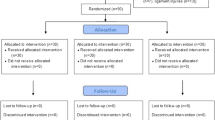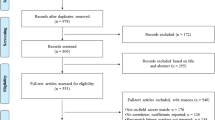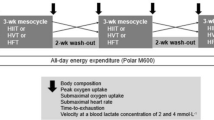Abstract
Purpose
Core and plyometric training may reduce injury and enhance muscle function in some athletes, but the effects on recreational marathon runners are unknown. Thus, the purpose of this study was to compare the effects of plyometric or core training on injury, muscle damage, and training variables in marathon runners.
Methods
This study was a randomized-controlled trial. 34 subjects, ages 18–23 (20.7 ± 1.3) following the same marathon training program, were allocated to one of three groups for a weekly training session: core, plyometric, or no additional training (control). Subjects kept a training log throughout training. Outcomes were assessed during the 8-week run-in (RI) and 13-week marathon training (MT) periods. The plyometric and core training group subjects were assessed pre- and post-marathon for creatine kinase (CK), a marker of muscle damage.
Results
The plyometric group did not change in any training variables between RI and MT. The core group increased in days missed due to injury (p = 0.003) and rate of perceived exertion (RPE) (p = 0.028). The control group increased in RPE (p = 0.010) and soreness (p = 0.010). The plyometric group had lower pre-marathon CK levels than the core group (81 ± 36 vs. 136 ± 59 U/L; p = 0.042). During MT, the plyometric group missed fewer days of training (plyometric: 1.7 ± 2.9; core: 4.2 ± 5.1; control: 4.5 ± 4.8) and missed fewer days due to injury (plyometric: 1.2 ± 2.6; core: 2.7 ± 5.1, control; 4.1 ± 4.9) but the differences were not significant.
Conclusions
A weekly plyometric training session may be superior to core or no additional training in improving training variables of recreational marathon runners.

Similar content being viewed by others
References
Lun V, Meeuwisse W, Stergiou P, Stefanyshyn D (2004) Relation between running injury and static lower limb alignment in recreational runners. Br J Sports Med 38:576–580. https://doi.org/10.1136/bjsm.2003.005488
Kluitenberg B, van Middelkoop M, Diercks R, van der Worp H (2015) What are the differences in injury proportions between different populations of runners? A systematic review and meta-analysis. Sports Med 45:1143–1161. https://doi.org/10.1007/s40279-015-0331-x
Malisoux L, Nielsen RO, Urhausen A, Theisen D (2015) A step towards understanding the mechanisms of running-related injuries. J Sci Med Sport 18:523–528. https://doi.org/10.1016/j.jsams.2014.07.014
Maughan RJ, Miller J (1983) Incidence of training-related injuries among marathon runners. Br J Sports Med 17:162–165. https://doi.org/10.1136/bjsm.17.3.162
Fredericson M, Misra AK (2007) Epidemiology and aetiology of marathon running injuries. Sports Med 37:437–439. https://doi.org/10.2165/00007256-200737040-00043
van Middelkoop M, Kolkman J, Van Ochten J, Bierma-Zeinstra SM, Koes B (2008) Prevalence and incidence of lower extremity injuries in male marathon runners. Scand J Med Sci Sports 18:140–144. https://doi.org/10.1111/j.1600-0838.2007.00683.x
Satterthwaite P, Norton R, Larmer P, Robinson E (1999) Risk factors for injuries and other health problems sustained in a marathon. Br J Sports Med 33:22–26. https://doi.org/10.1136/bjsm.33.1.22
van der Worp H, Vrielink J, Bredeweg S (2016) Do runners who suffer injuries have higher vertical ground reaction forces than those who remain injury-free? A systematic review and meta-analysis. Br J Sports Med 50:450–457. https://doi.org/10.1136/bjsports-2015-094924
Noakes T, Carter J (1982) The responses of plasma biochemical parameters to a 56-km race in novice and experienced ultra-marathon runners. Eur J Appl Physiol Occup Physiol 49:179–186. https://doi.org/10.1007/BF02334066
Macera CA, Pate RR, Powell KE, Jackson KL, Kendrick JS, Craven TE (1989) Predicting lower-extremity injuries among habitual runners. Arch Intern Med 149:2565–2568. https://doi.org/10.1001/archinte.149.11.2565
Holmich P, Christensen SW, Darre E, Jahnsen F, Hartvig T (1989) Non-elite marathon runners: health, training and injuries. Br J Sports Med 23:177–178. https://doi.org/10.1136/bjsm.23.3.177
van Mechelen W (1997) The severity of sports injuries. Sports Med 24:176–180. https://doi.org/10.2165/00007256-199724030-00006
Fuller CW, Eckstrand J, Junge A, Anderson TE, Bahr R, Dvorak J et al (2006) Consensus statement on injury definitions and data collection procedures in studies of football (soccer) injuries. Scand J Med Sci Sports 16:83–92. https://doi.org/10.1111/j.1600-0838.2006.00528.x
Taunton JE, Ryan MB, Clement DB, McKenzie DC, Lloyd-Smith DR, Zumbo BD (2002) A retrospective case-control analysis of 2002 running injuries. Brit J Sport Med 36:95–101. https://doi.org/10.1136/bjsm.36.2.95
Venckunas T, Skurvydas A, Brazaitis M, Kamandulis S, Snieckus A, Moran CN (2012) Human alpha-actinin-3 genotype association with exercise-induced muscle damage and the repeated-bout effect. Appl Physiol Nutr Metab 37:1038–1046. https://doi.org/10.1139/h2012-087
Kyrolainen H, Takala TE, Komi PV (1998) Muscle damage induced by stretch-shortening cycle exercise. Med Sci Sports Exerc 30:415–420
Hikida RS, Staron RS, Hagerman FC, Sherman WM, Costill DL (1983) Muscle fiber necrosis associated with human marathon runners. J Neurol Sci 59:185–203. https://doi.org/10.1016/0022-510X(83)90037-0
Kyrolainen H, Pullinen T, Candau R, Avela J, Huttunen P, Komi PV (200) Effects of marathon running on running economy and kinematics. Eur J Appl Physiol 82:297–304
Petersen K, Hansen CB, Aagaard P, Madsen K (2007) Muscle mechanical characteristics in fatigue and recovery from a marathon race in highly trained runners. Eur J Appl Physiol 101:385–396. https://doi.org/10.1007/s00421-007-0504-x
Kim HJ, Lee YH, Kim CK (2009) Changes in serum cartilage oligomeric matrix protein (COMP), plasma CPK and plasma hs-CRP in relation to running distance in a marathon (42.195 km) and an ultra-marathon (200 km) race. Eur J Appl Physiol 105:765–770. https://doi.org/10.1007/s00421-008-0961-x
Jones DA, Newham DJ, Round JM, Tolfree SE (1986) Experimental human muscle damage: morphological changes in relation to other indices of damage. J Physiol 375:435–448. https://doi.org/10.1113/jphysiol.1986.sp016126
Kim HJ, Lee YH, Kim CK (2007) Biomarkers of muscle and cartilage damage and inflammation during a 200 km run. Eur J Appl Physiol 99:443–447. https://doi.org/10.1007/s00421-006-0362-y
Riley WJ, Pyke FS, Roberts AD, England JF (1975) The effect of long-distance running on some biochemical variables. Clin Chim Acta 65:83–89. https://doi.org/10.1016/0009-8981(75)90338-1
Siegel AJ, Silverman LM, Lopez RE (1980) Creatine kinase elevations in marathon runners: relationship to training and competition. Yale J Biol Med 53:275–279
Nosaka K, Clarkson PM (1995) Muscle damage following repeated bouts of high force eccentric exercise. Med Sci Sports Exerc 27:1263–1269. https://doi.org/10.1249/00005768-199509000-00005
McHugh MP, Connolly DA, Eston RG, Gleim GW (1999) Exercise-induced muscle damage and potential mechanisms for the repeated bout effect. Sports Med 27:157–170. https://doi.org/10.2165/00007256-199927030-00002
Clarkson PM, Hubal MJ (2002) Exercise-induced muscle damage in humans. Am J Phys Med Rehabil 81:S52–S69. https://doi.org/10.1097/00002060-200211001-00007
Williardson J (2007) Core stability training: applications to sports conditioning programs. J Strength Cond Res 21:979–985. https://doi.org/10.1519/00124278-200708000-00054
McGill SM (2001) Low back stability: from formal description to issues for performance and rehabilitation. Exerc Sport Sci Rev 29:26–31
Chimera NJ, Swanik KA, Swanik CB, Straub SJ (2004) Effects of plyometric training on muscle-activation strategies and performance in female athletes. J Athl Train 39:24–31
Marti B, Vader JP, Minder CE, Abelin T (1988) On the epidemiology of running injuries. Am J Sports Med 16:285–294. https://doi.org/10.1177/036354658801600316
Chorley JN, Cianca JC, Divine JG, Hew TD (2002) Baseline injury risk factors for runners starting a marathon training program. Clin J Sport Med 12:18–23. https://doi.org/10.1097/00042752-200201000-00007
Lundstrom CL, Betker MR, Ingraham SJ. Effects of plyometric and explosive speed training on recreational marathoners (2017) J Sports Sci 5:1–13. https://doi.org/10.17265/2332-7839/2017.01.001
Aliverti A, Kayser B, Mauro AL, Quaranta M, Pompilio P, Dellaca RL et al (2011) Respiratory and leg muscles perceived exertion during exercise at altitude. Respir Physiol Neurobiol 177:162–168. https://doi.org/10.1016/j.resp.2011.03.014
Grant S, Aitchison T, Henderson E, Christie J, Zare S, McMurray J et al (1999) A comparison of the reproducibility and the sensitivity to change of visual analogue scales, borg scales, and likert scales in normal subjects during submaximal exercise. Chest 116:1208–1217. https://doi.org/10.1378/chest.116.5.1208
Andersen LL, Jay H, Andersen DC, Jakobsen GM, Sundstrup E, Topp R, Behm DG (2013) Acute effects of massage or active exercise in relieving muscle soreness: Randomized controlled trial. J Strength Cond Res 27:3352–3359. https://doi.org/10.1519/JSC.0b013e3182908610
Laurent MC, Green MJ, Bishop AP, Sjokvist EJ, Schumacker TR, Richardson T et al (2011) A practical approach to monitoring recovery: development of a perceived recovery status scale. J Strength Cond Res 25:620–628. https://doi.org/10.1519/JSC.0b013e3181c69ec6
Borg G (1998) Borg’s perceived exertion and pain scales. Human Kinetics, Champaign
Hildebrand DK. In Laing JD, Rosenthal H (eds) (1977) Analysis of ordinal data. Sage Publications, Beverly Hills
Jamurtas AZ, Fatouros IG, Buckenmeyer P, Kokkinidis E, Taxildaris K, Kambas A et al (2000) Effects of plyometric exercise on muscle soreness and plasma creatine kinase levels and its comparison with eccentric and concentric exercise. J Strength Cond Res 14:68–74. https://doi.org/10.1519/00124278-200002000-00012
Funding
No external funding was used to support this research.
Author information
Authors and Affiliations
Corresponding author
Ethics declarations
Conflict of interest
The authors declare that they have no competing interests.
Ethics approval
This study and all procedures were in accordance with the ethical standards of the institution and with the 1964 Helsinki declaration and its later amendments or comparable ethical standards. It was approved by the Institutional Review Board at the University of Minnesota—Twin Cities.
Informed consent
All participants provided written, informed consent after being informed about the protocol and purpose of the study.
Electronic supplementary material
Below is the link to the electronic supplementary material.
Rights and permissions
About this article
Cite this article
Lundstrom, C.J., Russell, H.C., O’Donnell, K.J. et al. Core and plyometric training for recreational marathon runners: effects on training variables, injury, and muscle damage. Sport Sci Health 15, 167–174 (2019). https://doi.org/10.1007/s11332-018-0506-6
Received:
Accepted:
Published:
Issue Date:
DOI: https://doi.org/10.1007/s11332-018-0506-6




